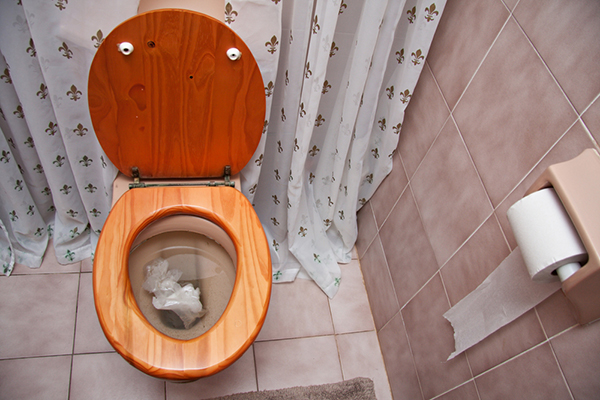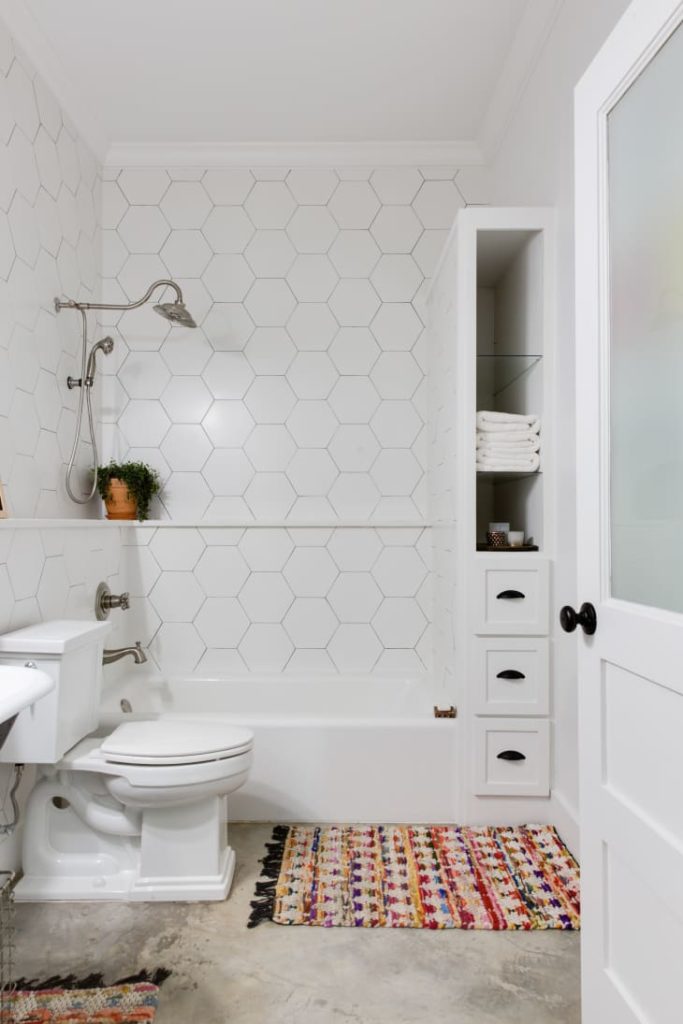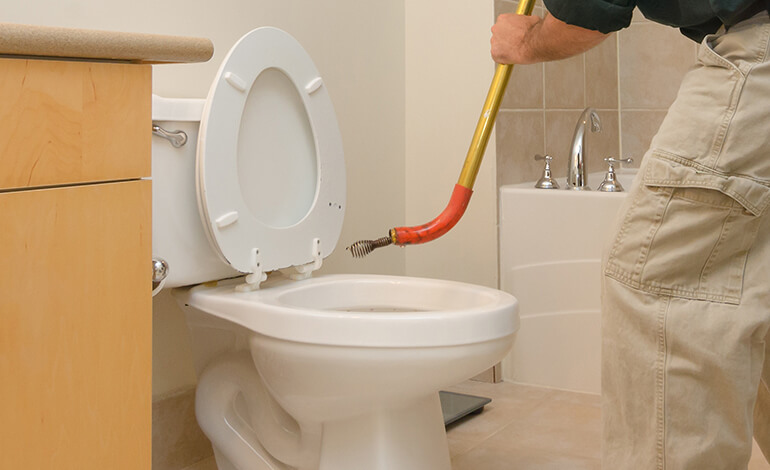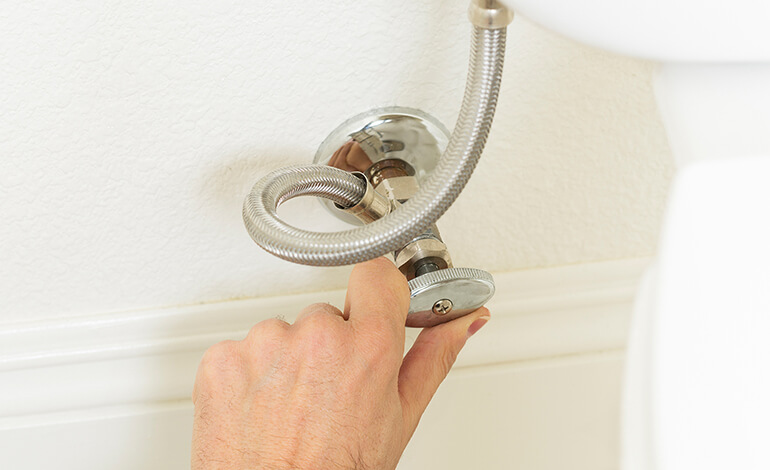HOW TO UNCLOG A TOILET
Of all the clogs out there, toilet clogs are the worst…for obvious reasons. But don’t rush to call a plumber—chances are good you can banish toilet trouble on your own by taking these smart steps!
JUST SAY NO TO OVERFLOW
First, turn off the water. If your toilet is on the verge of overflowing (or has already begun to), this prevents any more water from entering your toilet and making the problem worse. Find the shutoff valve located behind the toilet, near the floor, and turn it clockwise.
PUT SOME MUSCLE (AND A PLUNGER) INTO IT
Funnel-cup plungers, with a flange extending from the bottom, are the best for toilets. First, make sure there’s enough water in the bowl to cover the bottom of the plunger. If there isn’t, pour more into the bowl. As you push the plunger down and up, remember that the upward pull is as important as the downward push, so put some muscle into it! (Just watch out for splashback.)
TRY A TOILET AUGER
OK, it’s time to take it to the next level with a handheld toilet auger. Buy one at the hardware store—just make sure the corkscrew end of the auger you put in the toilet has rubber over it, otherwise it will scratch the porcelain. Put it into the toilet hole and turn the handle clockwise. Once you’ve dislodged the obstruction, pull the auger out, give the toilet a few more plunges, and flush.
KNOW WHEN TO CALL THE PROS
Even the best of us need to know when to ask for help. If a plunger and auger still aren’t doing the trick, it’s time to call a professional.

This is The Right Way to Unclog a Toilet With a Plunger
Clogged toilets are just one of those inescapable, yucky facts of life. Rather than the fear-filled I’ll just flush it again and see what happens technique (that can end in the disaster of disgusting water sloshing all over the bathroom floor) or the simultaneously frantic and hopeful thrusts of a plunger that may or may not work, it helps to know how to unclog a toilet the right way
First, Avoid Overflows
If the toilet is clogged, avoid repeated flushing. Remove the tank lid from the toilet and finding the round rubber flapper at the center of the bottom of the tank. If the water is rising and threatens to spill over, push the flapper down over the hole to keep water from flowing into the toilet bowl. Or turn off the water at the valve (the silver almond-shaped handle, usually located behind the toilet near the floor).
Use the Right Plunger, the Right Way
The most straightforward way to unclog a toilet is to address the issue with a plunger. The first step is making sure you have the right plunger for the job.
Alternate Methods Without a Plunger
What about those times when you’re stuck without a plunger, or are too embarrassed to ask for one? Like those absolutely dreadful situations when you clog a toilet at someone else’s house? Shudder. Luckily, there are some excellent life-hacker ways to unclog a toilet without a plunger
Before You Call A Plumber
If you aren’t able to unclog your toilet with any of the methods listed above, the next step is to try a toilet auger. It’s cheaper than a plumber.

When you need a plumber for a clogged toilet?
It’s difficult to think of anything worse than a clogged toilet. It keeps you from enjoying your bathroom properly and it can cause serious distress for the whole family. There are several reasons for a clogged toilet, ranging from obstructions to build up, to improper plumbing. The reality is, despite the cause, all homeowners want is for it to be cleared and gone. Of course, you still need to figure out the cause and possibly take some steps to relieve the clog quickly and easily.
Step One: Don’t Flush Your Toilet More Than Once
To begin with, if your toilet doesn’t completely flush after your first try, then whatever you do don’t flush it again. All you will do is cause it to overflow onto your bathroom floor and pump more water into the toilet bowl unnecessarily. Start by taking the lid off your toilet tank, and close the flapper at the top to prevent more water from flowing into the bowl. The flapper is a circular rubber piece that stops water from flowing in and out of the toilet
Step Two: Prep Your Environment
After you have prevented the toilet from overflowing onto the floor, it is still a good idea to prep the environment by placing paper towels or newspapers around the bottom of the bowl. Turn on your ventilation system to keep the air fresh and prevent foul odors from filling up the room. This will make it easier to work and unclog the drain. You might also want to grab a pair of rubber gloves, and throw on some old clothes.
Step Three: Avoid Plunging if There’s an Obstruction
The next step is to see if there is an obstruction inside the pipe. You may already be aware of this if your child has thrown a toy down the pipe or something else is obstructing the water from freely flowing. If you can see the obstruction, grab your gloves and pull out the obstruction with your own hands. If you can’t see it and can’t reach it, then use your plunger gently. However, the best bet is to avoid plunging and try something else instead.
Step Four: Use a Plunger
If there is no solid obstruction, then go ahead and use your plunger. If you do, ensure that your plunger is high quality for the best results. Either a ball shaped plunger or a plunger with a fold-out rubber flange on the bottom part which forms a suction seal, is best. If your plunger is not sealing, then it’s not working. It’s also a good idea to put the plunger under hot water for a few minutes to soften it and prep it for the toilet

Why Does My Toilet Keep Clogging?
Low Flow Toilet
One common reason a toilet may frequently be clogging is that you have a first generation low flow toilet, which means your toilet is older.
You Flushed a Non-Flushable Item
Toilets are designed to only dispose of specific materials, such as human waste and toilet paper.
Clogged Trap
There is an S-shaped trap between the drain line and the bowl which can become clogged or backed up with toilet paper.
Blocked Plumbing Vent
Modern toilets use roof vents to funnel fresh air into the plumbing system and boost flushing pressure. Over time, the vents can become blocked or clogged with sticks, leaves, or even a bird’s nest.
Clogged Sewer Line
Your toilet may become clogged on a regular basis if there is a blockage in the sewer line.

Don’t Call The Plumber Just Yet: How To Unclog Your Toilet
A home toilet clog doesn’t necessarily mean that you have to call the plumber right away
Avoid an overflow situation by opening the top of the toilet and closing the “flap.” The flap is usually a round, rubber part that you can temporarily disconnect or lower, and then reconnect or raise when the clog is cleared. Or, you can turn off the water supply at the base of the toilet while you work on eliminating the clog.
Do your best to determine whether the clog is caused by organic matter or by a foreign object (like a plastic toy) before choosing a course of action
If you have one, try a plunger first. Many people mistakenly put the plunger into the hole at the bottom of the bowl instead of over it. Make sure there’s water to cover the rubber top of the plunger to create a seal. Often, people stop plunging too soon. Be patient as it may take a few minutes or more of plunging to completely clear the clog.
For organic matter clogs, try heating a pot or kettle of water on the stove. Boiling water can actually crack a toilet bowl, so make sure the water is below the boiling point. Pour a half a box (or more) of baking soda into the clogged toilet bowl, followed by an equal amount of vinegar. Then, add the hot (but not boiling) water. Let the mixture stand for several hours or overnight before you try to flush again. If you don’t have vinegar and baking soda, you can add some dish soap, shampoo, or liquid soap to the hot (but not boiling) water and let that remain in the bowl for several hours or overnight.